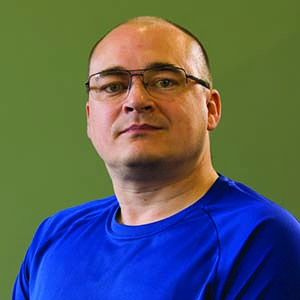Biography
Following degrees in Computer Science (University of Essex) and Biochemistry & Neuroscience (Keele), I earned my PhD in Biomedical Engineering, studying under Prof Divya Chari (Keele, 2013). During my PhD, I was awarded an EPSRC E-TERM Landscape Fellowship, also hosted in Prof Chari’s lab (2013-15). I then held a postdoc position with Dr David Morgan (Keele, School of Pharmacy; 2015-16), before becoming a Lecturer at Keele’s School of Medicine (Nov 2016-).
- PhD title: Applications of magnetic particles for oligodendrocyte precursor cell transplantation strategies
- Fellowship project, E-TERM (Engineering – Tissue Engineering and Regenerative Medicine; EP/I017801/1): Magnetically-assisted neuroengineering techniques
- Postdoc project: Investigating the roles of microglia in neurodegenerative disease and regenerative processes
Research and scholarship
I am interested in improving preclinical models of neurodegeneration in the central nervous system, particularly for screening nanomaterials with therapeutic potential for tissue engineering/regenerative medicine (TERM).
I mainly work with glial cells (astrocytes, oligodendrocytes, OPCs and microglia), but also embryonic stem cells (ESCs) and neurons (particularly dopaminergic).
I am associated with two themes at the Institute for Science and Technology in Medicine (ISTM):
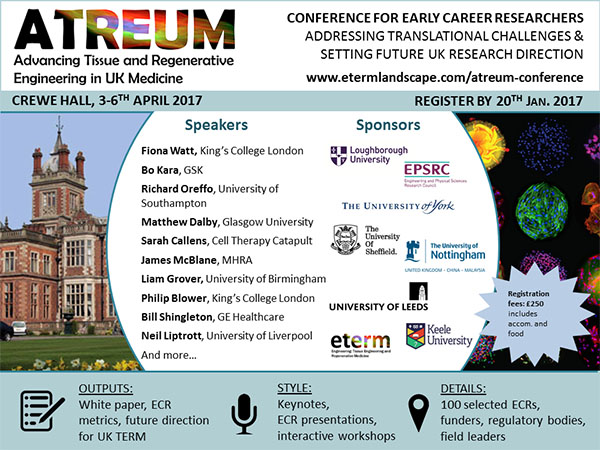
I organised the ATREUM conference (3-6 April 2017) for early career researchers in Tissue Engineering and Regenerative Medicine (TERM)
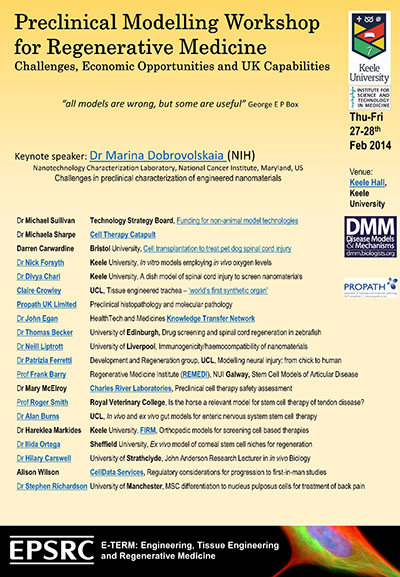
In Feb 2014, I organised a Preclinical Modelling Workshop for Regenerative Medicine at Keele Hall.
I am a member of the British Neuroscience Association (BNA) and the British Society for Immunology (BSI).
Teaching
I teach at Keele University Medical School, and am currently involved in curriculum development (MBChB).
Postgraduate Supervision:LSC-40043, MSc in Scientific Research Training
Further information
Links, Resources, News
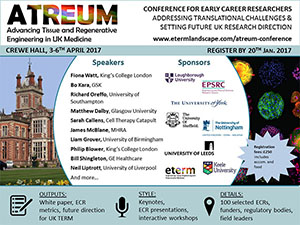
- I am organising the ATREUM conference (3-6 April 2017) for early career researchers in Tissue Engineering and Regenerative Medicine (TERM)
- I coordinate the Brains for Breakfast (B4B) seminar series
School of Life Sciences, Huxley003, Weds 09:00-10:00
Informal seminars discussing recent and proposed research in Neuroscience-related subjects, including Computer Science.
Please contact me if you are interested in presenting, or would like to join the mailing list.
- I have contributed to the HEART (Healthcare Engineering & Regenerative Therapies) blog, aimed at teenagers interested in science
Are nanoparticles too small to be seen interacting with cells? [Jun 2014]
Can ‘stealth’ nanoparticles deliver medicine to the brain? [Apr 2014]
News, Events
- Drs Stuart Jenkins & Chris Adams appointed to Lectureships [Oct 2016]
- Teenagers in UK Science + Engineering Competition final [Feb 2016]
- Are nanoparticles too small to be seen interacting with cells? [Jun 2014]
- Can ‘stealth’ nanoparticles deliver medicine to the brain? [Apr 2014]
- Preclinical Modelling Workshop for Regenerative Medicine [Feb 2014]
- Cover image in prestigious publication [Jan 2014]
- Journal Cover Image for Dr Divya Chari and Dr Stuart Jenkins [Jul 2013]
- Dr Stuart Jenkins has been awarded an Engineering & Physical Sciences Research Council (EPSRC) Landscape Fellowship [Nov 2012]
- British Neuroscience Association Abstract Competition Winner [Jul 2012]
- ISTM student paper in top nanotechnology journal [Oct 2011]
Publications
Gallery
- Three of my publications have featured as journal covers
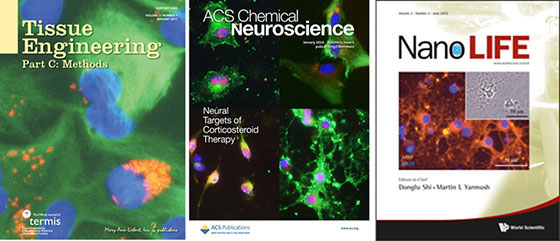
- Videos, produced using time-lapse fluorescence microscopy
Fluorescent magnetic nanoparticles being internalised by brain cells
PhD Students
Lab members, opportunities
- Emma Green, PhD student (2016-)
Vitamin driven generation of dopaminergic neurons as cell replacement therapy for Parkinson’s disease
- Michael Santer, MSc Scientific Research Training (2016-)
Serum-free media for neural cell culture
- Shida “Tiggs” Gholamian, Keele medical student, INSPIRE Summer Studentship (2016, with Dr David Morgan)
Eight week project: “Does repeated activation generate an ‘experienced’ microglial phenotype, with altered pro-inflammatory responses?”
- Anna Biju, Nuffield Research Placement (2016, with Dr David Morgan)
Anna Biju won a place in the national finals of the National Science + Engineering Competition (British Science Association, BSA), presenting our work at The Big Bang Fair. Covered in The Sentinel.
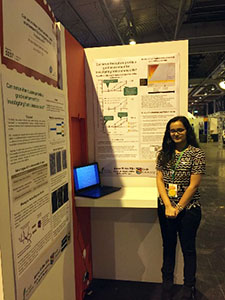
- Students wanted:
I welcome applications to undertake postgraduate (PhD or MPhil) studies in my laboratory. Please contact me directly (s.i.jenkins@keele.ac.uk) to discuss potential projects and the application process. See the "Research and Scholarship" tab for my research interests.
School of Life Sciences,
Huxley Building,
Keele University,
Staffordshire,
ST5 5BG
Tel: +44 (0) 1782 734414
Enquiries:
Tel: +44 (0) 1782 734414
Email: lifesciences.office@keele.ac.uk


